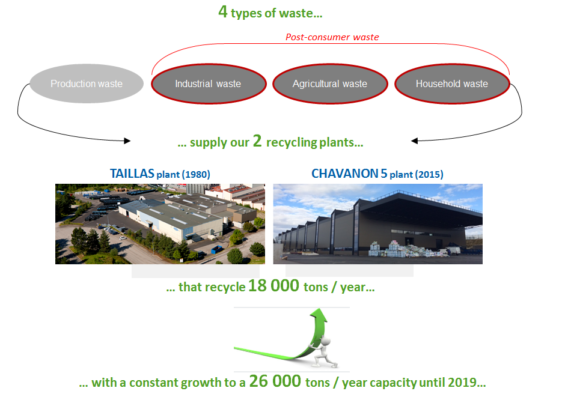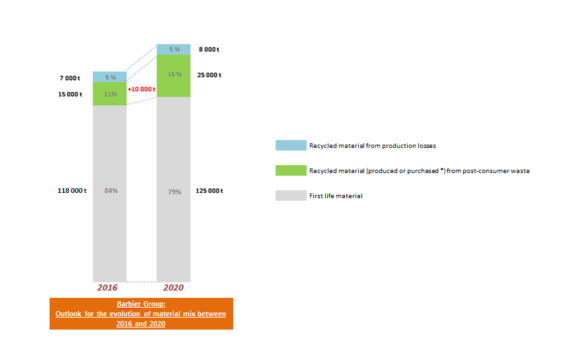Who better than a recycler to talk about recycled material!
Above all, the Barbier Group is a polyethylene transformer. For more than 35 years now, it has been transforming and recycling plastic waste to use it in its production of dustbin bags or agricultural films, and, more recently, in the production of industrial films.
In 1980, further the 2 oil price shocks and the first environmental awareness, Abel BARBIER launched the first recycling plant of the group on Les Taillas site. Then, it took several years of development (R&D) and optimization to Barbier Group to be able to produce the best recycled raw materials. These recycled raw materials led to the successes we know, especially on the agricultural and retail sector.
The Barbier Group, fully aware of the value and potential of the recycled raw material, and with the focus to speed up its voluntary environmental policy, invested in a new recycling plant which production started in April 2015.
The environmental preservation and the circular economy are at the heart of the Barbier Group’s strategy and investments.
– The first recycling plant is now dedicated to the recycling of the industrial and household post-consumer waste, and of our own production waste.
– The new Chavanon 5 plant is focused on the recycling of the agricultural, industrial and household post-consumer wastes.
Here after a reading grid on the origins of the plastic wastes the Barbier Group recycles:
- Production waste: our job is not to produce waste; that’s why waste represents only 5 % of our total production (140 000 tons). Moreover, our extruders are equipped with a system which reintegrates production losses directly into the production process. Production waste is so far the easiest to recycle and to use: there is no contamination and the formulation is precisely known. Since 35 years now, Barbier Group has been recycling 100 % of its production wastes!
- Industrial post-consumer waste: Our customers are our own waste suppliers. To get the best waste quality (which matches our technical and visual requirements), we need a qualified, quantified and controlled material flow, to provide our customers with all the required guarantees and traceability. This waste is difficult to generate: our customers have to sort waste (paper / cardboard and plastics) and, even, to separate transparent plastics from colored or printed films.
- Household post-consumer waste: Thanks to the extension of sorting instructions, we are starting to generate a regular flow of household waste. These wastes are the most difficult to recycle due to their level of contamination and the frequent presence of unwanted materials. The sorting of such waste upstream of our recycling plants (in sorting centers) is growing quickly but is not yet optimal.
- Agricultural post-consumer waste: The APE (Agriculture Plastic & Environment, association of agricultural films manufacturers, with Barbier Group as a member) finances and organizes the collection of used agricultural films in France. This is how the Barbier Group can attract this waste flow. These wastes are often damp and very dirty (soil, sand etc…) with some degrees of sorting error (stones, woods, scrap iron). On average, with 2 tons of agricultural waste, we produce 1 ton of recycled material.

Barbier and recycling
Thanks to its recycling activity, the Barbier Group offers a recycling material solution for 100 % of films sold on the market.
A 100 % integrated recycler
All of our recycled material productions are allocated to Barbier Group’s internal uses. Being a 100 % integrated recycler makes it possible to be highly reactive for the tests and the development of recycled materials we produce.
We systematically aim to the Upcycling: the waste recycling “from the top”. For this reason, we apply drastic procedures in terms of traceability and characterization of the waste we use.
Our obsession as an integrated recycler is to produce and to use recycled raw material with constantly improved quality in order to provide our customers with a maximum of added value, innovation and distinction.

For the most common applications, Barbier Group also partly purchases recycled raw material from other companies. The Barbier Group focuses its recycling units on the production of premium quality recycled raw materials providing the highest added value to its customers.
Why did we create the Recyplast® Industrial Film?
Recyplast® is the real recycled film because it integrates 20 % of authentic post consumer waste.
Why post-consuming?
Because it’s the only long-term flow which falls within the circular economy. The post-consumer waste volumes are important and regular. The carbon footprint is strongly reduced.
By choosing to be a plastic transformer / regenerator, the Barbier Group guarantees its customers with a secure and long-term supply, a total control of the quality and a perfect traceability of the waste. For Barbier Group, regularity and sustainability of the quality of our product is a real leitmotiv.
Linear economy vs circular economy
The recycled material from post production waste keeps us in a linear model (to extract, produce, use, and throw away).
The opposite direction taken by the Barbier Group, i.e. the recycling of post-consumer waste, projects us in a circular model (to reduce, reuse, collect, and recycle).
To talk about recycled material from post production waste is a speech of the past, the future and the major interest of recycling is that the post-consumer wastes are becoming a resource!
Why 20 %?
This ratio is a work basis tested and approved in our R&D laboratories (Optical and mechanical properties etc.…) .It’s only by working closely with our customers that we will go further. The evolution of this ratio will depend on the expected targets:
- To integrate more recycled raw material, but for which purposes?
- To down gauge thicknesses, but under which conditions?
Our argumentations focus on 3 main axes:
- 1st axe = a full circular economy!
The BARBIER Group produces films, sold for a first use, and then captures the waste (from household, industrial or agricultural origin), recycles it and benefits from this potential by developing a new product.
- 2nd axe = clear decrease of the carbon footprint with post-consumer waste
- 3rd axe = self-sufficiency in raw material and partly secured supplies

